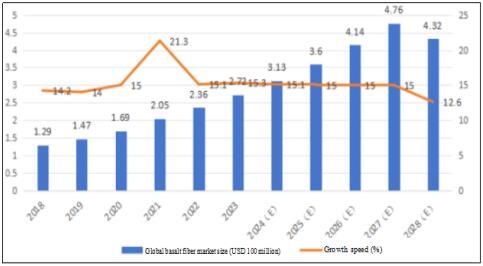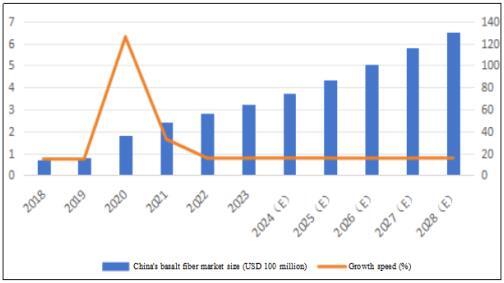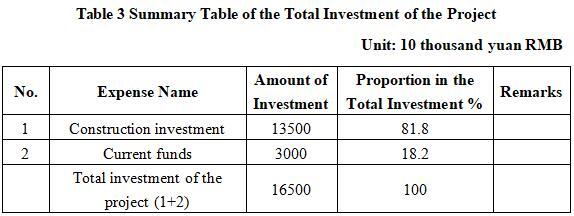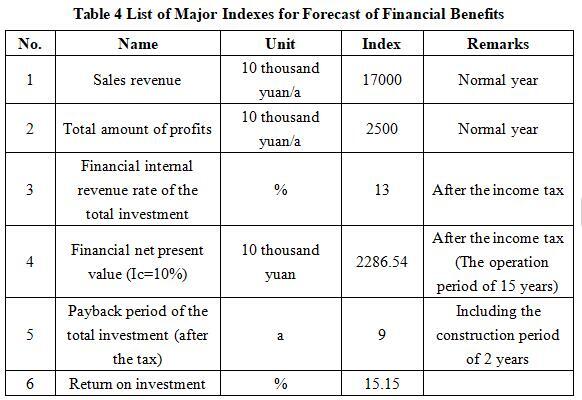New Material
An Annual Output of 3,000 Tons of Basalt Fiber Material Project of Baishan City
1. Introduction to the Project
1.1 Project background
1.1.1 Product introduction
Basalt fiber is a continuous fiber made of natural basalt as raw material, melted at 1,450°C~1,500°C and then drawn at high speed by platinum rhodium alloy wire drawing leakage plate, composed of oxides such as silicon dioxide, alumina, calcium oxide, magnesium oxide, iron oxide and titanium dioxide, which is a new type of inorganic environmental protection green high-performance fiber material.
The project uses basalt materials to produce basalt continuous fibers with high strength, electrical insulation, corrosion resistance, high temperature resistance and other excellent properties, which are used in the construction industry, transportation industry, petrochemical industry, light industry and textile industry.
1.1.2 Market prospect
1. The development process of basalt fiber at home and abroad
In 1840, basalt fiber was successfully trial-produced in Wales, England; In 1922, the Frenchman Paul proposed and patented the technology of manufacturing basalt continuous fibers, but there was no substantial industrial production; In 1954, the Moscow Research Institute of Glass and Plastics in the Soviet Union developed basalt continuous fibers; In 1985, the first industrial production furnace was built and put into operation in the Ukrainian Fiber Laboratory, using the 200-hole leakage plate and combined furnace drawing process. The former Soviet Union started industrial production in the mid-80s of the 20th century, achieved industrialized production in the late 90s, and became the largest producer and consumer of basalt fiber. In 2019, the annual output of global basalt fiber was about 30,000 tons, mainly concentrated in Ukraine, Russia, China, the United States, Germany, Belgium and other countries, mainly used in military industry, oil and gas pipelines. Relatively speaking, the research on basalt fiber in China is relatively late. In the early stage of continuous basalt fiber industrialization in China, the process technology of the former Soviet Union was introduced or imitated, and the basalt fiber production line was established by relying on the technical personnel of the glass fiber industry. In the mid-90s of the 20th century, Nanjing Fiberglass Research & Design Institute was the first to start the research of ultra-fine basalt fibers, which were mainly used in the field of military industry. In 2001, the basalt fiber research team of Harbin Institute of Technology built a single furnace spinning device in Chengdu Aerospace Base; In November 2002, China included “continuous basalt fiber and its composite materials” in the national 863 plan; At the end of 2003, the first basalt fiber production enterprise in China, Ejin Basalt Fiber Co., Ltd., was established in Shanghai; In 2004, China's basalt fiber began to be industrialized in Shanghai, mainly producing continuous basalt fiber with a diameter of more than 11 μm; In 2018, Sichuan Fiberglass Group Co., Ltd. became the first enterprise in the world to successfully use the pool kiln method to produce continuous basalt fiber, achieving a production capacity of 8,000t/a. After decades of development, China has become one of the main producers of basalt fiber in the world.
2. The current situation of the global basalt fiber industry
In recent years, the market size of global basalt fiber has been growing, reaching 205 million US dollars in 2021, a year-on-year increase of 21.3%. In 2023, the market size of global basalt fiber reached 1.476 billion yuan. It is estimated that by 2028, the scale of China's basalt fiber market will reach $432 million, with an average compound annual growth rate of 12.6%.
Table 1 Global basalt fiber market size and growth rate from 2018 to 2028

3. The current situation of China's basalt fiber industry
(1) Basalt mining volume
Traditional basalt is mainly used as paving stones in building materials or construction stones in various projects, and some are also used in the production of cast stones, rock wool, etc. In general, the development and utilization of basalt by traditional methods has not achieved a great improvement in the production and application value of basalt. With the emergence of basalt continuous fibers, the development, production and application of basalt have made a qualitative leap. In recent years, the amount of basalt mining in China has gradually increased. In 2022, China's basalt mining volume was 85.4 million tons, a year-on-year increase of 4.4%, an increase of 32.6 million tons compared with 2015, and a compound growth rate of 7.11% from 2015 to 2022. In 2023, the mining of basalt in China reached 120 million tons.
(2) Basalt consumption
In recent years, with the rapid development of the national economy, the demand for basalt continuous fiber and its composite materials in the fields of national defense construction, transportation, construction, petrochemical, environmental protection, electronics, aviation, aerospace and other fields is increasing. At the same time, China's iron ore resources are scarce, and the use of basalt continuous fiber products to replace steel in roads, bridges and buildings is gradually increasing. In 2022, China's basalt consumption was 81.5 million tons, a year-on-year increase of 3.82%, of which the consumption of construction and building materials accounted for 98.5%, and other fields accounted for 1.5%. In 2023, the consumption of basalt was 87.67 million tons, and the market size was 2.456 billion yuan.
As an important product in basalt products, basalt fiber is also expanding its market size. Basalt continuous fiber has excellent performance and has been applied in auto parts, electronic appliances and other fields, and the market demand is high. China is the world's largest basalt fiber production base and an important consumer of basalt fiber. In 2021, the scale of China's basalt fiber market reached 243 million yuan, a year-on-year increase of 32.8%. It is estimated that by 2028, the scale of China's basalt fiber market will reach 654 million yuan, with an average compound annual growth rate of 15.9%.
Table 2 China's basalt fiber market sizeand growth rate from 2018 to 2028

From the perspective of regional structure, China's basalt fiber and its products market is mainly concentrated in densely populated areas with developed manufacturing, infrastructure and other industries, with certain regional characteristics. Among them, East China has the largest market size, accounting for 40.74%, followed by Central China and South China, accounting for 13.58% and 13.17% respectively. It is expected that in the future, with the application and promotion of basalt fiber in the western region, the market share of the northwest, southwest and other regions will increase. The scale of China's basalt fiber market has a high growth rate in various regions, among which the northwest, southwest, northeast and other regions have the highest growth rate, reaching 17.1%, 16.9% and 16.7% respectively. This shows that basalt fiber has great application potential in these regions and is expected to become an emerging market in the basalt fiber industry. At the same time, East China, Central China, South China and other regions are still the main consumer markets of basalt fiber, accounting for most of the market share, which is related to the dense population, developed the manufacturing, infrastructure and other industries in these regions. Therefore, the basalt fiber industry needs to formulate corresponding development strategies according to the market characteristics of different regions to achieve market optimization and expansion.
4. Development prospects of China's basalt fiber industry
With the increasing global emphasis on environmental protection and sustainable development, basalt fiber, as an environmentally friendly and renewable material, will receive more attention. Its excellent fire resistance and high temperature resistance make it a great potential to replace traditional materials. Secondly, the application of basalt fiber in the fields of buildings, roads, bridges and other fields can improve the durability and safety of buildings and infrastructure, and the growth of demand for buildings and infrastructure will also bring more opportunities for the basalt fiber industry.
1.1.3 Technical analysis
The technical support unit of this project is Sichuan Aerospace Tuoxin Basalt Industrial Co., Ltd., which is a high-tech enterprise jointly invested by China Aerospace Science and Technology Group Investment Holding Co., Ltd., Shenzhen Aerospace of Technology Innovation Research Institute, Shenzhen Guochuangheng Science and Technology Development Co., Ltd., Shenzhen Research Institute of Harbin Institute of Technology and Chengdu Aerospace Wanxin Science & Technology Co., Ltd., which is mainly engaged in R&D, production and sales of high-performance basalt fibers and fiber products. The TX-1 basalt continuous fiber production equipment developed by Sichuan Aerospace Tuoxin Basalt Industrial Co., Ltd. has complete functions, and has realized automation in furnace temperature control, furnace flame monitoring, leakage plate temperature, power failure and gas outage protection; The fiber manufacturing technology is at the leading level in China, among which the temperature uniformity control technology and heat exchange leakage plate technology have reached the international advanced level; The annual output of a single furnace can reach 100 tons, and clean production is realized.
1.1.4 Advantageous conditions of project construction
(1) Policy advantages
“Made in China 2025” points out that the development of high-performance composite materials will be accelerated, including carbon fiber, basalt fiber, resin matrix, ceramic matrix composite materials, etc.
The “Implementation Plan for Quality Improvement and Upgrading of the Textile Industry (2023-2025)” proposes to break through the shortcomings of high-performance fibers and their composite materials such as carbon fiber (48K and above large tow, T1100 grade, M65J grade), aramid (high strength, high modulus), high-strength and high-modulus polyimide fiber, ultra-high molecular weight polyethylene fiber (high strength, creep resistance), continuous basalt fiber, silicon carbide fiber, poly-ter-benzene-supported benzodiooxazole fiber and other high-performance fibers and their composite materials, and improve the research and development, manufacturing and application level of polylactic acid fiber, lyocell fiber, and bio-based polyamide fiber, propylene terephthalate fiber, seaweed fiber, chitosan fiber and other bio-based chemical fibers and raw materials.
(2) Resource advantages
Hydropower Resources: There are two major water systems of Yalu River and Songhua River in Baishan City, and 55 large rivers such as Yalu River, Songhua River, and Hunjiang River, with a basin area of more than 100 square kilometers, the main reservoir area of the famous Baishan Power Station and Yunfeng Power Station is located in Baishan City, the city's average total water resources for many years is 8.025 billion cubic meters, the per capita share of water resources is 2.7 times that of the national per capita share, the theoretical reserves of water energy are 1.061 million kilowatts, and the developable hydropower resources are 842,000 kilowatts.
Natural resources: Jiangyuan District, which is known as the “treasure house of three-dimensional resources”, mainly has mineral resources, forests, water conservancy, wild animals and plants, and other natural resources, and has proven 28 kinds of mineral resources, including 375 million tons of coal reserves, 300 million tons of iron ore reserves, 26 million tons of songhua stone reserves, 47.76 million tons of shale soil reserves, and 920,000 cubic meters of basalt reserves.
Land resources: The total land area of the district is 134,695.06 hectares, including 11,587.82 hectares of cultivated land, 557.257 hectares of orchard land, 113,677.39 hectares of forest land, 878.68 hectares of grassland, 52.99 hectares of wetland, 824.87 hectares of water, 6,514.82 hectares of construction land and 601.24 hectares of other land.
(3) Industrial advantages
Baishan basalt development enterprises mainly process basalt plates, slats and other primary products, and the development of basalt new material industry is still in its infancy. During the “14th Five-Year Plan” period, Baishan City plans to make use of the rich basalt resources of Changbai Mountain to build a project with an annual output of 10,000 tons of continuous basalt fiber drawing and its products, and promote the development of basalt industry in the direction of basalt fiber, fiber textile yarn, basalt untwisted roving, basalt unidirectional cloth, basalt composite bar, basalt pipe and stone plastic composite materials.
At present, relying on the green and low-carbon new material industrial park, Jiangyuan District has done a good job in the development of non-metallic mineral resources such as basalt and limestone, accelerated the construction of new high-efficiency activated calcium and regenerated black soil projects with an annual output of 1 million tons in Xinruilai, and made every effort to promote the start of projects such as basalt industrial park and prefabricated housing materials demonstration base, and accelerated the construction of a new material industrial system supported by mineral resources.
(4) Talent advantages
63,800 professional and technical personnel in Baishan City; 13,000 highly skilled talents, including 39 young and middle-aged experts with outstanding contributions; There are 13 top innovative talents, and a talent team has begun to take shape, with a relatively complete range of categories and gradually increasing overall strength. Changbaishan Vocational and Technical College is a public ordinary university with higher education enrollment qualifications approved by the Jilin Provincial Government and recorded by the national education. The college is a multi-level and multi-category teaching higher vocational college that focuses on higher education, takes into account secondary vocational education, and carries out social training and vocational skills certification education at the same time. The college has 18 higher vocational majors for national enrollment and 12 secondary vocational majors for provincial enrollment. The training center of the college has more than 30 projects of skills training and vocational qualification education in six categories, with an annual training capacity of 5,000 people.
(5) Location advantages
Jiangyuan District is located in the central area of six counties (cities and districts) of Baishan City, and is the only gateway from Liaoning, Hebei, Shandong, Beijing and other places to Changbai Mountain Tourist Scenic Area through National Highway 201, 270 kilometers away from Changchun Longjia Airport, 100 kilometers away from Changbaishan Airport, 90 kilometers away from Tonghua Airport, 50 kilometers away from Linjiang Port, 162 kilometers away from Ji'an Port, and 392 kilometers away from Dandong Port. It is an important place for logistics distribution. The highways and railways in the region are crossed, and five national and provincial trunk roads such as Hegang-Dalian Line and Shenyang-Changbai Line run through the territory, and two railway trunk lines, Hunjiang-Erdaobaihe Line and Yayuan-Dalizi Line, connect the north and south. Jiangyuan has formed a one-hour economic circle in Baishan City. With the successive completion of high-speed railways and airports, Jiangyuan District will form a three-hour economic circle with Beijing, Dalian, Shenyang and other places, and the sharing of factors will be more convenient and smooth.
1.2 Contents and scale of project construction
With an area of 45,000 square meters and a construction area of 15,150 square meters, the project is planned to purchase production equipment, and construct supporting wire drawing workshop, winding and yarn mixing workshops, warehouses and office facilities.
1.3 Total investment of the project and capital raising
1.3.1 Total investment of the project
The total investment of this project is 165 million yuan, including construction investment of 135 million yuan and current funds of 30 million yuan.

1.3.2 Capital raising
Self-funded by enterprises
1.4 Financial analysis and social evaluation
1.4.1 Main financial indexes
After the project reaches the production capacity, its annual sales income will be 170 million yuan, its profit will be 25 million yuan, its investment payback period will be 9 years (after the tax, including the construction period of 2 years) and its investment profit rate will be 15.15%.

Note: “10 thousand yuan” in the table is in RMB.
1.4.2 Social evaluation
The basalt fiber and its composite materials produced by the project can better meet the needs of structural materials in the fields of national defense construction, transportation, construction, petrochemical, environmental protection, electronics, aviation, aerospace, etc., and play an important role in promoting national defense construction, major projects and industrial structure upgrading.
1.5 Cooperative way
Joint venture, cooperation, sole proprietorship, other ways are negotiable.
1.6 What to be invested by the foreign party
Funding, other ways are negotiable.
1.7 Construction site of the project
Jiangyuan District, Baishan City.
1.8 Progress of the project
We are attracting foreign investment.
2. Introduction to the Partner
2.1 Basic information
Name: Bureau of Commerce of Jiangyuan District, Baishan City
Address: Building 25, Fuqiang Phase 2, Jiangyuan District, Baishan City
2.2 Overview
Baishan City is a prefecture-level city under the jurisdiction of Jilin Province, located on the west side of Changbai Mountain, adjacent to Yanbian Korean Autonomous Prefecture in the east, Tonghua City in the west, Jilin City in the north, and the Democratic People's Republic of Korea across the Yalu River in the south, located in the hinterland of Changbai Mountain, Longgang Mountain Range and Laoling Mountain Range run diagonally through the whole territory, belonging to the north temperate continental monsoon climate, with a total area of 17,505 square kilometers. The city has jurisdiction over 2 districts, 2 counties, 1 autonomous county, and 1 hosted county-level city. As of the end of 2023, the city has a population of 895,900.
Jiangyuan District is located in the southeast of Jilin Province. It is located between 126°23'~127°11'E longitude and 41°48'~42°13'N latitude, bordering Fusong County in the east, Liuhe County and Badaojiang District in the west, Linjiang City in the south, and Jingyu County in the north. It is 69 kilometers from east to west and 44.4 kilometers from north to south, with a total area of 1,347 square kilometers.
Jiangyuan District has always adhered to the guidance of Xi Jinping's socialist thought with Chinese characteristics in the new era, fully implemented the spirit of the important instructions of General Secretary Xi Jinping's important speech on inspecting Jilin, focused on the core strategic arrangement and overall leading direction of the municipal party committee, based on the new development stage, implemented the new development concept, integrated into the new development pattern, created new development advantages, adhered to the ecological district, strong industrial area, characteristic rich area, and innovative development area, and thoroughly implemented the “1151” development strategy, insisted on revitalizing the stock, expanding the increment and striving for the upper level unswervingly, and doing a solid job “Six Stabilities”, fully implement the “Six Guarantees” task, continue to create a new situation of green transformation and high-quality development, and strive to advance the second centenary goal of building socialist modernization in an all-round way.
2.3 Contact method
Contact unit: Baishan Municipal Bureau of Commerce
Contact person: Zhu Yuze
Tel: +86-439-3367020
+86-15844990231


